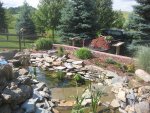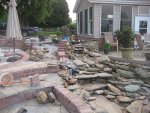Hi-
This will be a confessional for me but I need help from those of you who are knowledgeable about the chemistry of water quality.
So I have a POND, a new pond, fairly large 126,000 gallons with a fountain that circulates the water once each day ie 126000 gal/ day. NO FISH.
When the pond was built, it immediately turned green. Now here's the chemistry problem. I used a couple of gallons of chelated copper algecide. But it didn't help, I guess because I had microscopic planktonic algae. Then I used Hydrothol, another differently acting algaecide/herbicide. It didn't work. So my pondmaster sugggested alum--aluminum sulfate. It didn't help.
For three months, nothing worked to kill the algae. So my pondmaster suggested Shocking the pond like a pool. He did this and it almost instantly started killing the algae. IT WORKED. He put 50 gallons of shock in my pond. However, now my pond is Carribean Blue which doesn't look natural, and the plants are dying(which I knew would happen).
Now I need to turn my pond from Carribean Blue to Natural somehow. I don't know if I just wait for the chlorine to burn off a few days or whether a chemical reaction between the copper ions of the algaecides, and sulfates and the hypochlorite caused the blue color. I also have a white film on the black liner which Pondmaster has suggested is dead algae, bleached out.
So I have lost faith in him and turn to YOU. I know this is not strictly a pool problem, but it is interesting!! I have a blue lagoon that needs dealing with.
HELP!!!
This will be a confessional for me but I need help from those of you who are knowledgeable about the chemistry of water quality.
So I have a POND, a new pond, fairly large 126,000 gallons with a fountain that circulates the water once each day ie 126000 gal/ day. NO FISH.
When the pond was built, it immediately turned green. Now here's the chemistry problem. I used a couple of gallons of chelated copper algecide. But it didn't help, I guess because I had microscopic planktonic algae. Then I used Hydrothol, another differently acting algaecide/herbicide. It didn't work. So my pondmaster sugggested alum--aluminum sulfate. It didn't help.
For three months, nothing worked to kill the algae. So my pondmaster suggested Shocking the pond like a pool. He did this and it almost instantly started killing the algae. IT WORKED. He put 50 gallons of shock in my pond. However, now my pond is Carribean Blue which doesn't look natural, and the plants are dying(which I knew would happen).
Now I need to turn my pond from Carribean Blue to Natural somehow. I don't know if I just wait for the chlorine to burn off a few days or whether a chemical reaction between the copper ions of the algaecides, and sulfates and the hypochlorite caused the blue color. I also have a white film on the black liner which Pondmaster has suggested is dead algae, bleached out.
So I have lost faith in him and turn to YOU. I know this is not strictly a pool problem, but it is interesting!! I have a blue lagoon that needs dealing with.
HELP!!!



